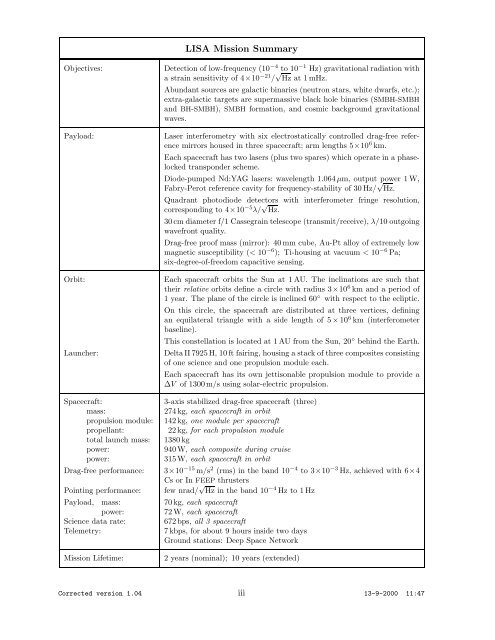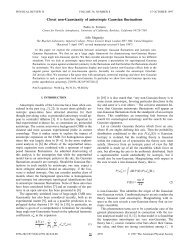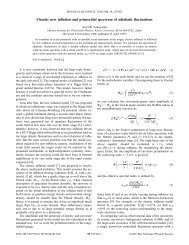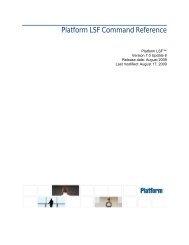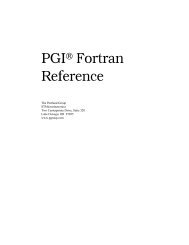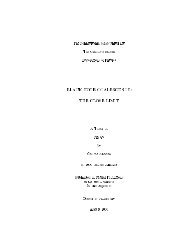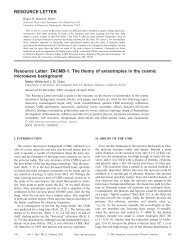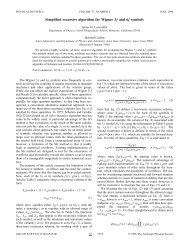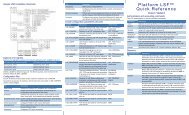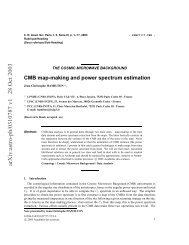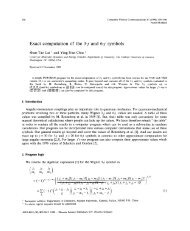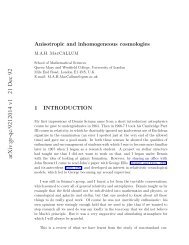- Page 1: LISA Laser Interferometer Space Ant
- Page 6 and 7: 13-9-2000 11:47 iv Corrected versio
- Page 8 and 9: Foreword making the detection of gr
- Page 10 and 11: 13-9-2000 11:47 viii Corrected vers
- Page 12 and 13: Contents 3.4.1 The proof mass . . .
- Page 14 and 15: Contents 7.5.5 Estimation of backgr
- Page 16 and 17: Contents 11.3 SMART 2 technologies
- Page 18 and 19: Contents References 307 Acronyms 31
- Page 20 and 21: Executive Summary varying strain in
- Page 22 and 23: Executive Summary which are only ob
- Page 24 and 25: 13-9-2000 11:47 6 Corrected version
- Page 26 and 27: Chapter 1 Scientific Objectives poi
- Page 28 and 29: Chapter 1 Scientific Objectives par
- Page 30 and 31: Chapter 1 Scientific Objectives 1.1
- Page 32 and 33: Chapter 1 Scientific Objectives bec
- Page 34 and 35: Chapter 1 Scientific Objectives whe
- Page 36 and 37: Chapter 1 Scientific Objectives 1.2
- Page 38 and 39: Chapter 1 Scientific Objectives bea
- Page 40 and 41: Chapter 1 Scientific Objectives are
- Page 42 and 43: Chapter 1 Scientific Objectives the
- Page 44 and 45: Chapter 1 Scientific Objectives it
- Page 46 and 47: Chapter 1 Scientific Objectives -15
- Page 48 and 49: Chapter 1 Scientific Objectives If
- Page 50 and 51: Chapter 1 Scientific Objectives the
- Page 52 and 53: 13-9-2000 11:47 34 Corrected versio
- Page 54 and 55:
Chapter 2 Different Ways of Detecti
- Page 56 and 57:
MNPO MNO QRTS QUS V2SWO XZY¢O [¦\
- Page 58 and 59:
Chapter 2 Different Ways of Detecti
- Page 60 and 61:
Chapter 2 Different Ways of Detecti
- Page 62 and 63:
Chapter 2 Different Ways of Detecti
- Page 64 and 65:
Chapter 3 The LISA Concept - An Ove
- Page 66 and 67:
Chapter 3 The LISA Concept - An Ove
- Page 68 and 69:
Chapter 3 The LISA Concept - An Ove
- Page 70 and 71:
Chapter 3 The LISA Concept - An Ove
- Page 72 and 73:
Chapter 3 The LISA Concept - An Ove
- Page 74 and 75:
Chapter 3 The LISA Concept - An Ove
- Page 76 and 77:
Chapter 4 Measurement Sensitivity 0
- Page 78 and 79:
Chapter 4 Measurement Sensitivity 1
- Page 80 and 81:
Chapter 4 Measurement Sensitivity (
- Page 82 and 83:
13-9-2000 11:47 64 Corrected versio
- Page 84 and 85:
Chapter 5 The Interferometer Figure
- Page 86 and 87:
Chapter 5 The Interferometer Figure
- Page 88 and 89:
Chapter 5 The Interferometer The pr
- Page 90 and 91:
Chapter 5 The Interferometer manufa
- Page 92 and 93:
Chapter 5 The Interferometer into t
- Page 94 and 95:
Chapter 5 The Interferometer The el
- Page 96 and 97:
Chapter 5 The Interferometer causin
- Page 98 and 99:
Chapter 5 The Interferometer betwee
- Page 100 and 101:
Chapter 5 The Interferometer - The
- Page 102 and 103:
13-9-2000 11:47 84 Corrected versio
- Page 104 and 105:
Chapter 6 Inertial Sensor and Drag-
- Page 106 and 107:
Chapter 6 Inertial Sensor and Drag-
- Page 108 and 109:
Chapter 6 Inertial Sensor and Drag-
- Page 110 and 111:
Chapter 6 Inertial Sensor and Drag-
- Page 112 and 113:
Chapter 6 Inertial Sensor and Drag-
- Page 114 and 115:
13-9-2000 11:47 96 Corrected versio
- Page 116 and 117:
Chapter 7 Signal Extraction and Dat
- Page 118 and 119:
Chapter 7 Signal Extraction and Dat
- Page 120 and 121:
Chapter 7 Signal Extraction and Dat
- Page 122 and 123:
Chapter 7 Signal Extraction and Dat
- Page 124 and 125:
Chapter 7 Signal Extraction and Dat
- Page 126 and 127:
Chapter 7 Signal Extraction and Dat
- Page 128 and 129:
Chapter 7 Signal Extraction and Dat
- Page 130 and 131:
Chapter 7 Signal Extraction and Dat
- Page 132 and 133:
Chapter 7 Signal Extraction and Dat
- Page 134 and 135:
Chapter 7 Signal Extraction and Dat
- Page 136 and 137:
Chapter 7 Signal Extraction and Dat
- Page 138 and 139:
Chapter 7 Signal Extraction and Dat
- Page 140 and 141:
Chapter 7 Signal Extraction and Dat
- Page 142 and 143:
Chapter 7 Signal Extraction and Dat
- Page 144 and 145:
Chapter 7 Signal Extraction and Dat
- Page 146 and 147:
¨ú $˜û # £',+&úù )*$$ Chapt
- Page 148 and 149:
Chapter 8 Payload Design 8.2.3 Payl
- Page 150 and 151:
Chapter 8 Payload Design should be
- Page 152 and 153:
Chapter 8 Payload Design Location T
- Page 154 and 155:
H Chapter 8 Payload Design - .0/214
- Page 156 and 157:
switchable bus control Chapter 8 Pa
- Page 158 and 159:
Chapter 9 Spacecraft Design assembl
- Page 160 and 161:
Chapter 9 Spacecraft Design The two
- Page 162 and 163:
Chapter 9 Spacecraft Design 9.3 The
- Page 164 and 165:
Chapter 9 Spacecraft Design Table 9
- Page 166 and 167:
Chapter 9 Spacecraft Design directi
- Page 168 and 169:
Chapter 9 Spacecraft Design Figure
- Page 170 and 171:
Chapter 9 Spacecraft Design Figure
- Page 172 and 173:
Chapter 9 Spacecraft Design 9.4.3 S
- Page 174 and 175:
Chapter 9 Spacecraft Design tempera
- Page 176 and 177:
Chapter 9 Spacecraft Design Tempera
- Page 178 and 179:
Chapter 9 Spacecraft Design Further
- Page 180 and 181:
Chapter 9 Spacecraft Design Normall
- Page 182 and 183:
Chapter 9 Spacecraft Design eject R
- Page 184 and 185:
Chapter 9 Spacecraft Design • The
- Page 186 and 187:
N&OP Q&RS2RUT VWRXY:Z X2M [?\:RP:PY
- Page 188 and 189:
Chapter 9 Spacecraft Design LEONARD
- Page 190 and 191:
Chapter 9 Spacecraft Design The fol
- Page 192 and 193:
Chapter 9 Spacecraft Design TM TC T
- Page 194 and 195:
Chapter 9 Spacecraft Design shall n
- Page 196 and 197:
Chapter 9 Spacecraft Design of the
- Page 198 and 199:
Chapter 9 Spacecraft Design 9.7.5 C
- Page 200 and 201:
Chapter 9 Spacecraft Design device
- Page 202 and 203:
13-9-2000 11:47 184 Corrected versi
- Page 204 and 205:
Chapter 10 Mission Analysis launch.
- Page 206 and 207:
Chapter 10 Mission Analysis maneuve
- Page 208 and 209:
Chapter 10 Mission Analysis separat
- Page 210 and 211:
Chapter 10 Mission Analysis Figure
- Page 212 and 213:
Chapter 10 Mission Analysis plane,
- Page 214 and 215:
Chapter 10 Mission Analysis Earth 5
- Page 216 and 217:
13-9-2000 11:47 198 Corrected versi
- Page 218 and 219:
Chapter 11 Technology Demonstration
- Page 220 and 221:
Chapter 11 Technology Demonstration
- Page 222 and 223:
Chapter 11 Technology Demonstration
- Page 224 and 225:
Chapter 11 Technology Demonstration
- Page 226 and 227:
Chapter 12 Science and Mission Oper
- Page 228 and 229:
Chapter 12 Science and Mission Oper
- Page 230 and 231:
Chapter 12 Science and Mission Oper
- Page 232 and 233:
Chapter 12 Science and Mission Oper
- Page 234 and 235:
Chapter 12 Science and Mission Oper
- Page 236 and 237:
Chapter 12 Science and Mission Oper
- Page 238 and 239:
13-9-2000 11:47 220 Corrected versi
- Page 240 and 241:
Collaboration, Management, Schedule
- Page 242 and 243:
13-9-2000 11:47 224 Corrected versi
- Page 244 and 245:
Appendix LISA averaged Sensitivity
- Page 246 and 247:
Appendix stability of straylight pa
- Page 248 and 249:
Appendix serve aside from their fun
- Page 250 and 251:
Appendix Optical path-lengths: L 12
- Page 252 and 253:
Appendix • a fall-back configurat
- Page 254 and 255:
Appendix Table A.1 Null space of th
- Page 256 and 257:
Appendix • ambiguities exist betw
- Page 258 and 259:
Appendix Table A.3 Sensitivity of m
- Page 260 and 261:
Appendix ( ) −R ∂M ∂x j · st
- Page 262 and 263:
Appendix 0.1 Pathlength Error rad/S
- Page 264 and 265:
Appendix size in the phase meter. A
- Page 266 and 267:
Appendix Table A.4 Properties of th
- Page 268 and 269:
Appendix • Acceleration resulting
- Page 270 and 271:
Appendix Table A.7 Pre-Phase A opti
- Page 272 and 273:
Appendix effects. • Two types of
- Page 274 and 275:
Appendix -8 1. 10 Optical Path Erro
- Page 276 and 277:
Appendix A.2.2 Modelling the charge
- Page 278 and 279:
Appendix right through). The curve
- Page 280 and 281:
Appendix where the first term ( ˙Q
- Page 282 and 283:
Appendix The charge build-up will b
- Page 284 and 285:
Appendix The integration times give
- Page 286 and 287:
Appendix The integral divides natur
- Page 288 and 289:
Appendix shorter period than this,
- Page 290 and 291:
Appendix + HW HU R G\QH O DV HU L
- Page 292 and 293:
Appendix A.4.4 Laser metrology harn
- Page 294 and 295:
Appendix beamwidth of the diode las
- Page 296 and 297:
Appendix of less then 100 kHz in th
- Page 298 and 299:
Appendix The phase noise characteri
- Page 300 and 301:
Appendix Table A.14 Experimental re
- Page 302 and 303:
Appendix Table A.16 Photodiodes for
- Page 304 and 305:
Appendix Figure A.26 Telescope desi
- Page 306 and 307:
Appendix • minimise external stra
- Page 308 and 309:
Appendix A telescope with a CFRP st
- Page 310 and 311:
Appendix • no WFE impact over a -
- Page 312 and 313:
Appendix On the basis of the above
- Page 314 and 315:
Appendix
- Page 316 and 317:
Appendix A.7.4 Location of the cent
- Page 318 and 319:
Appendix A.7.4.4 Conclusion Conside
- Page 320 and 321:
Appendix The voice-coil solution wo
- Page 322 and 323:
Appendix The plots that will be pre
- Page 324 and 325:
13-9-2000 11:47 306 Corrected versi
- Page 326 and 327:
References [18] V.M. Lipunov, K.A.
- Page 328 and 329:
References [59] M.J. Rees: Astrophy
- Page 330 and 331:
References [101] L. Morgenroth, LIS
- Page 332 and 333:
References [135] B.T.C. Zandbergen,
- Page 334 and 335:
Acronyms - and other abbreviations
- Page 336 and 337:
Acronyms ETR Extended Tuning Range
- Page 338 and 339:
Acronyms NAO National Astronomical
- Page 340:
Acronyms TC TeleCommand TCS Thermal


